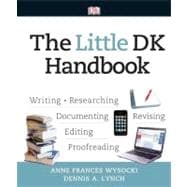
Note: Supplemental materials are not guaranteed with Rental or Used book purchases.
Purchase Benefits
What is included with this book?
PART 1 A PROCESS FOR ACADEMIC COMPOSING
What Is Composing? 2
What Is Rhetoric? 3
Rhetoric and a Process for Composing 4
Academic Writing 5
Writing in the Humanities 6
Writing in the Sciences 8
Writing in the Social Sciences 9
Understanding an Assignment 10
PART 2 FINDING IDEAS
A Research Process 12
Finding a Topic 13
Narrowing a Topic 14
Questions to Guide Research 16
Kinds of Sources 18
Kinds of Research 19
Determining Where to Research 20
Choosing Sources 22
Print 24
Webpages and Other Online Sources 26
Finding Sources Online 28
Using Library Catalogs 29
Using Library Journal Databases 30
Keeping Track of Sources 32
Evaluating Sources for Relevance 34
Evaluating Sources for Credibility 36
Starting a Paper 40
PART 3 ANALYZING IDEAS, GETTING ORGANIZED
What Is Analysis? 42
Analyzing to Understand 43
Identifying Rhetorical Strategies 44
Analyzing Thesis Statements 46
A Sample Rhetorical Analysis 48
Analyzing to Ask Questions 50
Questions for Critical Reading 51
Questions for Critical Writing 52
What Counts as Evidence 53
Using Analysis to Develop a Thesis Statement 55
Using a Thesis Statement to Organize an Academic Paper 56
Reasoning 58
PART 4 DRAFTING A PAPER, CONNECTING WITH AUDIENCES
Understanding Your Audience 60
Developing a Statement of Purpose 62
Shaping Paragraphs for Audience and Purpose 64
Unified and Coherent Paragraphs 65
Paragraphs That Develop 68
Writing a Draft 71
A Rough Draft 72
Once You’ve Finished a Draft 78
Receiving Feedback to a Draft 79
Responding to the Writing of Your Peers 80
PART 5 REVISING WITH STYLE
Revising Your Writing 82
Developing a Revision Plan 83
Styling Paragraphs 84
Concluding Paragraphs 85
Introductory Paragraphs 86
Transitions Between Paragraphs 87
Passive Voice 88
Styling Sentences 89
Academic Sentences 89
Sentences That Are Easy to Read 90
Parallelism 91
Using Coordination and Subordination 92
Using Inclusive Language 94
Styling Words 96
Action Verbs 97
Concrete Nouns 97
Clichés 98
Too Many Words 98
Jargon 98
PART 6 DOCUMENTING
Why Cite and Document Sources? 100
Plagiarism—and How to Avoid It 100
Citing and Documenting 101
Quoting Others’ Words 102
Summarizing and Paraphrasing 104
Collecting Citation Information 106
From Printed Books 106
From Printed Periodicals 108
From Webpages 110
From an Article You Find in a Database of Journals 112
MLA DOCUMENTATION 114
Guide to MLA Documentation Models 114
A Paper in MLA Format 116
A Works Cited Page in MLA Format 124
MLA Documentation for In-Text Citations 126
Variations on the MLA In-Text Citation Pattern 127
MLA Documentation for Works Cited 130
PATTERN: MLA Works Cited for Periodicals in Print 132
PATTERN: MLA Works Cited for Articles from Online Scholarly Journals and Databases 134
PATTERN: MLA Works Cited for Webpages 136
PATTERN: MLA Works Cited for Books 138
MLA Works Cited 140
Author’s Name 140
Titles 142
Periodical Volume, Issue, Number, and Date 146
Page Numbers for Periodical Articles 147
Place of Publication 148
Year of Publication 149
Website Titles 150
Additional Information 152
For Other Kinds of Texts 153
APA DOCUMENTATION 157
Guide to APA Documentation Models 157
Pages from a Paper in APA Format 158
A Reference List Page in APA Format 162
APA Documentation for In-text Citations 164
In-Text Citations in APA Style 165
Variations on the APA Pattern for In-text Citations 166
APA Documentation for Reference List Entries 168
PATTERN: APA References for Periodical Sources 170
PATTERN: APA References for Nonperiodical Sources 172
APA References 174
Author’s Name 174
Date of Publication 176
Place of Publication 177
Titles 178
Additional Information 180
Periodical Volume and Issue 181
For Online Texts 182
For Other Kinds of Sources 184
CSE DOCUMENTATION 186
Guide to CSE Documentation Models 186
CSE References 186
Details of the Patterns 187
CSE List of References 188
CSE In-text Citations 188
CSE Sample References 189
CMS DOCUMENTATION 191
Guide to CMS Documentation Models 191
CMS In-text Citations and Footnotes 191
Subsequent Note Entries 191
Bibliography 192
CMS Sample References 192
PART 7 EDITING AND PROOFREADING YOUR WORK
Editing and Proofreading 196
Subject-Verb Agreement 198
Shifts in Verb Tenses 202
Verbs in Academic Writing 204
Shifts in Grammatical Forms 206
Sentence Fragments 208
Run-on Sentences 212
Pronoun Reference and Agreement 214
Misplaced and Dangling Modifiers 216
The Difference Between Noun Possessives and Plurals 218
Using Articles Conventionally 220
Grammar 222
Nouns 223
Pronouns 224
Adjectives 226
Articles 227
Verbs 228
Main Verbs and Helping Verbs 230
Adverbs 231
Prepositions 232
Conjunctions 234
Building Sentences 238
Sentence Functions and Patterns 239
Simple Sentences 240
Subjects and Predicates 242
Independent Clauses 245
Compound Sentences 246
Complex Sentences 248
Compound-Complex Sentences 251
Punctuation 252
Commas 253
When Not to Use Commas 270
Colons 272
Semicolons 274
Ellipses 275
Parentheses 276
Dashes 278
Brackets 279
Hyphens 280
Slashes 281
Quotation Marks 282
Apostrophes 288
Periods 290
Question Marks 292
Exclamation Points 293
Mechanics 294
Using Italics and Underlining 294
Spelling 295
Capitalizing Words 296
Numbers 297
Abbreviations 298
Glossary 300
Credits 306
Index 307
Revision Symbols 316
Detailed Contents Back Cover
Revision Checklist Back Cover
The New copy of this book will include any supplemental materials advertised. Please check the title of the book to determine if it should include any access cards, study guides, lab manuals, CDs, etc.
The Used, Rental and eBook copies of this book are not guaranteed to include any supplemental materials. Typically, only the book itself is included. This is true even if the title states it includes any access cards, study guides, lab manuals, CDs, etc.